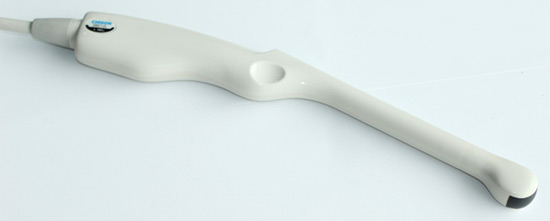Description
Chison E6-V Intra Cavity Probe for Sonobook
The versatile probe with a specialized range of applications:
Without FHI 4.0-10.0MHz
With FHI 4.8-12.0MHz
Micro convex Array
OBS GYN ERO
Scan Depth: 3.28-14.12mm
Elements: 128
Footprint: 37x12mm
FOV (Field of View): 120°
Chison E6-V Intra Cavity Probe for Sonobook – Precautions
Cleaning and Disinfecting
- Place the probe into the solution of cleaning-disinfectant. Make sure not to immerse the probe into the liquid beyond the immersion level given in the pictures below. Make sure that the probe is covered with the cleaning disinfectant up to the immersion level during the complete disinfection time.
- For the recommended cleaning and disinfection time, please see your Operating Manual. Scrub the probe as needed using a soft sponge, gauze, or cloth to remove all visible residue from the probe surface.
- Rinse the probe with enough clean, potable water to remove all disinfectant residues.
- Use a soft cloth to clean the cable and the user section of the probe with the cleaning disinfectant liquid. Make sure that the surface of the probe and cable is wetted thoroughly with the cleaning disinfectant.
- Allow the probe to air dry completely.
- Reconnect the probe to the ultrasound console and place the probe into its holder
Endo-cavitary Probe Handling Precautions
If the sterilization solution comes out of the endocavitary probe, please follow the cautions below:
Sterilant Exposure to Patient (e.g., Cidex)
Contact with a sterilant to the patient’s skin for mucous membrane may cause inflammation. If this happens, refer to the instruction manual of the sterilant.
Sterilant Exposure from Probe Handle to Patient (e.g. Cidex):
DO NOT allow the sterilant to contact the patient. Only immerse the probe to its specified level. Ensure that no solution has entered the probe’s handle before scanning the patient. If the sterilant comes into contact with the patient, refer to the sterilant’s instruction manual.
Sterilant Exposure from Probe connector to Patient (e.g. Cidex)
DO NOT allow the sterilant to contact the patient. Only immerse the probe to its specified level. Ensure that no solution has entered the probe’s connector before scanning the patient. If the sterilant comes into contact with the patient, refer to the sterilant’s instruction manual.
Endocavitary Probe Point of Contact:
Refer to the sterilant’s instruction
Coupling gels should not contain the following ingredients as they are known to cause probe damage:
- Methanol, ethanol, isopropanol, or any other alcohol-based product.
- Mineral oil
- Iodine
- Lotions
- Lanolin
- Aloe Vera
- Olive Oil
- Methyl or Ethyl Parabens (para hydroxybenzoic acid)
- Dimethyl silicone
Electrical shock hazard:
- The probe is driven with electrical energy that can injure the patient or user if live internal parts are contacted by a conductive solution:
- DO NOT immerse the probe into any liquid beyond the level indicated by the immersion level diagram. Never immerse the probe connector into any liquid.
- Prior to each use, visually inspect the probe lens and case area for cracks, cuts, tears, and other signs of physical damage. DO NOT use a probe that appears to be damaged until you verify functional and safe performance. You need to perform a more thorough inspection, including the cable, strain relief, and connector, each time you clean the probe.
- Before inserting the connector into the probe port, inspect the probe connector pins. If a pin is bent, DO NOT use the probe until it has been inspected and repaired/replaced by a CHISON Service Representative.
- Electrical leakage checks should be performed on a routine basis by CHISON Service or qualified hospital personnel.
Additional information
| Weight | 5 kg |
|---|
Recommended products
Nothing found.


